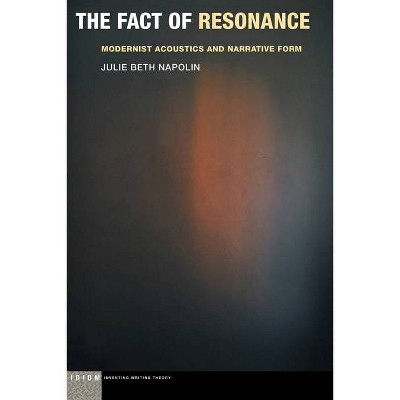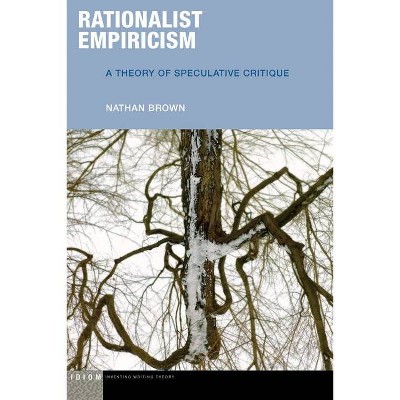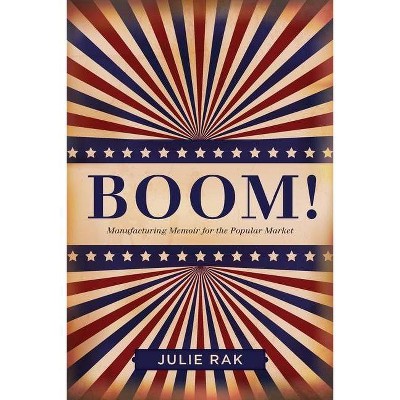The Fact of Resonance - (Idiom: Inventing Writing Theory) by Julie Beth Napolin (Paperback)

Similar Products
Products of same category from the store
AllProduct info
<p/><br></br><p><b> About the Book </b></p></br></br><i>The Fact of Resonance</i> returns to the colonial and technological contexts in which theories of the novel developed, seeking in sound an alternative premise for theorizing modernist narrative form. The book shows how the experience of reading is undergirded by the sonic.<p/><br></br><p><b> Book Synopsis </b></p></br></br><p><b>Shortlisted, 2021 Memory Studies Association First Book Award</b> <p/><i>The Fact of Resonance</i> returns to the colonial and technological contexts in which theories of the novel developed, seeking in sound an alternative premise for theorizing modernist narrative form. Arguing that narrative theory has been founded on an exclusion of sound, the book poses a missing counterpart to modernism's question "who speaks?" in the hidden acoustical questions "who hears?" and "who listens?" <p/>For Napolin, the experience of reading is undergirded by the sonic. The book captures and enhances literature's ambient sounds, sounds that are clues to heterogeneous experiences secreted within the acoustical unconscious of texts. The book invents an oblique ear, a subtle and lyrical prose style attuned to picking up sounds no longer hearable. "Resonance" opens upon a new genealogy of modernism, tracking from Joseph Conrad to his interlocutors--Sigmund Freud, Frantz Fanon, W. E. B. Du Bois, William Faulkner, and Chantal Akerman--the racialized, gendered, and colonial implications of acoustical figures that "drift" through and are transformed by narrative worlds in writing, film, and music. <p/>A major synthesis of resources gleaned from across the theoretical humanities, the book argues for "resonance" as the traversal of acoustical figures across the spaces of colonial and technological modernity, figures registering and transmitting transformations of "voice" and "sound" across languages, culture, and modalities of hearing. We have not yet sufficiently attended to relays between sound, narrative, and the unconscious that are crucial to the ideological entailments and figural strategies of transnational, transatlantic, and transpacific modernism. The breadth of the book's engagements will make it of interest not only to students and scholars of modernist fiction and sound studies, but to anyone interested in contemporary critical theory.</p><p/><br></br><p><b> From the Back Cover </b></p></br></br><p>"With meticulous attention to the aesthetics and politics of voice, sound, reading, listening, and the representation of others, Julie Beth Napolin offers an ear-opening set of resonances, restoring to the texts in question an audiovisual multiplicity entangled with race and ethnicity. This book is destined to reboot our reception of classics by Conrad, Du Bois, Fanon, Faulkner, and others. An admirably ambitious and nuanced study."--Rey Chow, co-editor of <i>Sound Objects</i> <p/>"This is a remarkable book, a truly interdisciplinary effort that brings the study of sound to bear on the very nature of narrative and the phenomenology of reading. Using a twinned approach to sound--both as acoustics and as sound-figures--allows Napolin to produce a wholly original set of engagements with the politics of colonialism, race, affect, and subjectivity in the modernist novel."--Brian Kane, Yale University <p/><i>The Fact of Resonance</i> returns to the colonial and technological contexts in which theories of the novel developed, seeking in sound an alternative premise for theorizing modernist narrative form. Arguing that narrative theory has been founded on an exclusion of sound, the book poses a missing counterpart to modernism's question "who speaks?" in the hidden acoustical questions "who hears?" and "who listens?" <p/>For Napolin, the experience of reading is undergirded by the sonic. "Resonance" names the traversal of acoustical figures across the spaces of colonial and technological modernity, figures that register and transmit transformations of "voice" and "sound" across languages, culture, and modalities of hearing. Moving between Joseph Conrad, W. E. B. Du Bois, William Faulkner, Frantz Fanon, Chantal Akerman, and others, Napolin captures and enhances literature's ambient sounds, sounds that are clues to heterogeneous experiences secreted within the acoustical unconscious of texts. <p/>Julie Beth Napolin is Assistant Professor of Digital Humanities in the Literature Program at the New School.</p><p/><br></br><p><b> Review Quotes </b></p></br></br><br>What happens to us, as readers, when a scholarly monograph's organizing principle is not progression or demonstration, but resonance? If we are lucky, we experience a theoretical acoustics that pairs ostensibly disparate ideas without hierarchizing them, indeed that contests the hierarchies implied by principles of causality, linearity, and teleology. With Julie Beth Napolin's<i> The Fact of Resonance</i>, we are lucky... After finishing Napolin's monograph, I opened another book, and I found myself listening differently.<b>---Jean-Thomas Tremblay, <i>Modernism/Modernity</i></b><br><br>In a moment when the voices of the oppressed are ringing out across the world, Julie Beth Napolin's <i>The Fact of Resonance </i>brings us toward the literary beginnings of modernism so that we can learn to listen for difference, which was never, contrary to some Fascist desires, completely contained.-- "Social Text"<br><br>It is an exciting time to be a Conradian. At the same time that many of us are contending with well-intentioned but misplaced efforts to right literary discourse by eradicating Conrad from the canon, recent works of criticism are broadening the scope of investigation into his works and allowing us to rethink his writing in radically new ways. Such critical work is important; it confirms the author's place in academic discussion and provides new avenues of research that attest to his continuing importance in the future. Julie Beth Napolin's <i>The Fact of Resonance</i> is a welcome contribution to this enterprise. It allows us to see beyond the abstractions of narrative voice and to hear, feel and experience Conrad's writing anew.-- "Joseph Conrad Today"<br><br>This is a remarkable book, a truly interdisciplinary effort that brings the study of sound to bear on the very nature of narrative and the phenomenology of reading. Using a twinned approach to sound--both as acoustics and as sound-figures--allows Napolin to produce a wholly original set of engagements with the politics of colonialism, race, affect, and subjectivity in the modernist novel.<b>---Brian Kane, Yale University, <i></i></b><br><br>With meticulous attention to the aesthetics and politics of voice, sound, reading, listening, and the representation of others, Julie Beth Napolin offers an ear-opening set of resonances, restoring to the texts in question an audiovisual multiplicity entangled with race and ethnicity. This book is destined to reboot our reception of classics by Conrad, Du Bois, Fanon, Faulkner, and others. An admirably ambitious and nuanced study.<b>---Rey Chow, co-editor of Sound Objects, <i></i></b><br><p/><br></br><p><b> About the Author </b></p></br></br>Julie Beth Napolin is Assistant Professor of Digital Humanities in the Literature Program at The New School. She has published on sound, media, and literature in <i>qui parle</i>, <i>Symploke</i>, <i> Sounding Out!</i>, and <i>Social Text</i> and in such volumes as <i>Vibratory Modernism</i>, <i>Sounding</i> <i>Modernism</i>, and <i>Fifty Years after Faulkner</i>. In 2012 she was awarded a Bruce Harkness Young Scholar Award by the Joseph Conrad Society of America
Price History
Price Archive shows prices from various stores, lets you see history and find the cheapest. There is no actual sale on the website. For all support, inquiry and suggestion messagescommunication@pricearchive.us



















